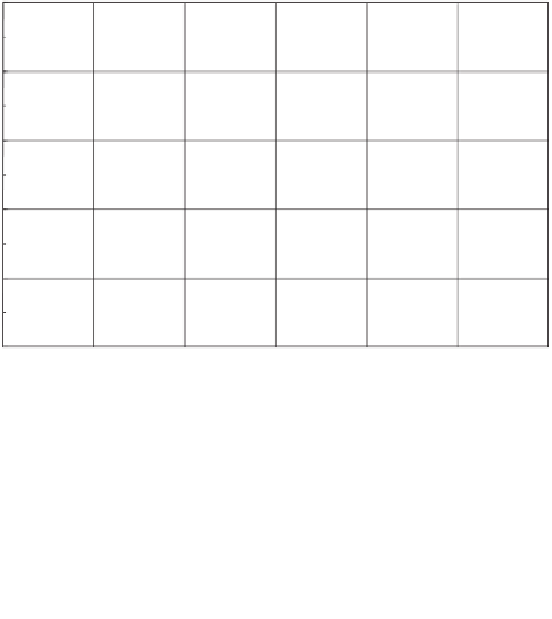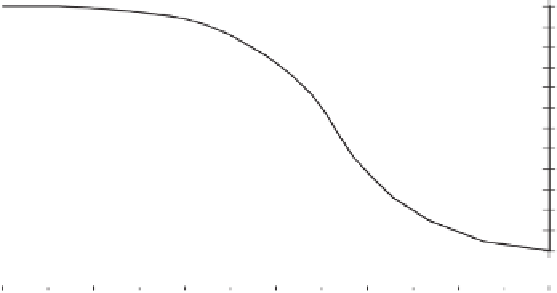Environmental Engineering Reference
In-Depth Information
8.2.4 Statistical Models for Estimation of Permeability
Function
There are groups of proposed estimation models that are
based on statistical assumptions regarding the pore distri-
butions. The statistical models are developed based on the
interpretation of the SWCC. These models are usually cat-
egorized as either macroscopic approaches or microscopic
approaches. The macroscopic models provide a closed-form
analytical equation for the unsaturated permeability function
and are related to either the normalized water content
n
or
the dimensionless water content
d
.
where:
k
w
θ
i
=
calculated coefficient of permeability for a
specified volumetric water content
θ
i
corre-
sponding to the
i
th interval,
i
=
interval number that increases with decreasing
water content (e.g.,
i
1 identifies the first
interval that closely corresponds to the satu-
rated water content
θ
s
and
i
=
m
identifies the
last interval corresponding to the lowest water
content
θ
L
on the experimental SWCC),
=
j
=
counter from
i
to
m,
k
sc
=
calculated saturated coefficient of permeability,
8.2.4.1 Childs and Collis-George Model with
Modifications by Marshall and Others
Childs and Collis-George (1950) proposed a model for esti-
mating the coefficient of permeability based on a random
variation in pore sizes. The assumption is made that the
overall volume change of the soil is negligible as soil suc-
tion is increased. The model was later improved by Marshall
(1958) and further modified by Kunze et al. (1968). A per-
meability function
k
w
(θ)
was derived based on Poiseuille's
equation. The following permeability function is similar in
form to the function presented by Kunze et al. (1968). The
function has been slightly modified to accommodate SI units
and a matric suction designation rather than a pore-water
pressure head. Variables used in the equation are illustrated
in Fig. 8.4. The matric suction corresponding to the mid-
point of each interval is used to calculate the coefficient of
permeability:
T
s
=
surface tension of water,
ρ
w
=
density of water,
g
=
gravitational acceleration,
υ
w
=
absolute viscosity of water,
p
=
constant that accounts for the interaction of
pores of various sizes,
=
m
total number of intervals between the saturated
volumetric water content
θ
s
and the lowest
water content
θ
L
on the experimental SWCC
N
=
total number of intervals computed between
the saturated volumetric water content
θ
s
and
zero water content (i.e.,
θ
=
0) (note that
N
=
m
θ
s
/
θ
s
−
θ
L
,
m
≤
N
, and
m
=
N
when
θ
L
=
0), and
ψ
j
=
soil suction (kPa) corresponding to the mid-
point of the
j
th interval (Fig. 8.5).
The calculation of the water coefficient of permeability,
k
w
, at a specific volumetric water content,
(θ)
i
, involves the
summation of the matric suction values that correspond to
the volumetric water contents at and below a specific vol-
umetric water content,
(θ)
i
. Several procedures have been
(
2
j
j
m
θ
s
N
2
k
w
θ
i
=
T
s
ρ
w
g
2
υ
w
2
i)
u
a
−
u
w
−
2
k
s
k
sc
+
1
−
j
=
i
i
=
1
,
2
,...,m
(8.8)
0.5
i
=1
s
Midpoint
of the 4th
increment
s
0.4
2
3
4
4th
increment
(u
a
-
u
w
)
4
0.3
5
6
7
m
=12
8
0.2
9
(
w
)
4
i
=
m
10
11
0.1
12
l
0
0
10
20
30
40
50
60
Matric suction (
u
a
-
u
w
), kPa
Figure 8.4
Calculation of water coefficient of permeability function from the SWCC (after
Marshall, 1958; Kunze et al., 1968).

































Search WWH ::

Custom Search